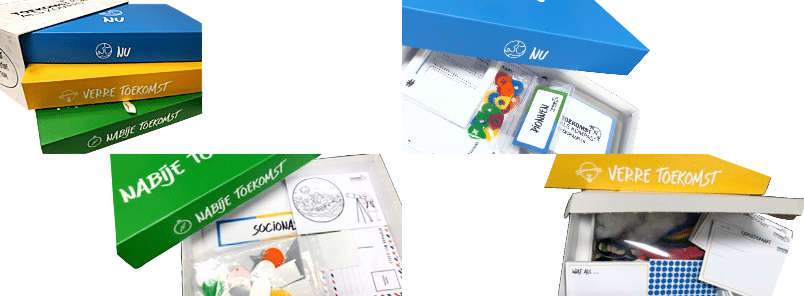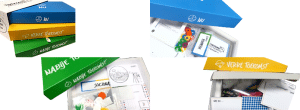How can we use the future as a compass and connect it to action in the present? A transmedia toolkit, Toekomst Als Kompas (TAK), which translates as Future as Compass, facilitates design-oriented future thinking with stakeholders in a social issues.
The TAK toolkit challenges you and helps bring potential distant futures into the present to experience and explore. Not to better predict what will happen, but to more systemically explore the possible non-linear consequences of human actions in the here and now. People often have various expectations about the future, based on which they act now, only to later find that the future has unfolded differently and often undesirably. Exploring unforeseen, unorthodox futures broadens the view of possibilities, leading to different solutions and perspectives for action. It also allows you to look at current actions differently, understanding that what we do now partly determines how the future unfolds for the next generations.
Imagine the day after extreme rainfall and flooded basements, a persuasive note on the door of your next meeting informs you that your boss, colleague, or teacher cannot be physically present, but asks you to pick up the ‘full-sense holosuit’ at the reception for a face-to-face VR meeting. Would you check it out just to be sure? Or would you immediately regret getting up early? How would you prefer to use such a holosuit? And if we all were to have such a holosuit in the future, what would we do with all the office and school space that becomes available? Or the six-lane A2 highway between Utrecht and Amsterdam where you could hear a pin drop? Such a holosuit obviously consumes energy, or would it actually encourage us to move more because the computer screen surrounds us 360 degrees instead of us sitting down staring at it? Could that movement ever generate enough energy?
With TAK, you design and create future probes, or design artifacts from the distant future, making future worlds where other values prevail accessible in the present. Future probes estrange the familiar world, provoking immediate, emotional reactions. This triggers a reflective dialogue to further explore the future worlds that such a future probe reveals. As in the example above. It starts with a concrete probe, a small experience, which helps spark your imagination. This leads to asking the questions needed to have a dialogue about how we, as humans, want to live in the future in a world that largely unfolds beyond our direct control.
Future Probing is a way to create difference (significant difference) in or between (system) containers (e.g., groups of people working towards the same mission), leading to exchange (information flow, dialogue, etc.). Probing is also a method to navigate complexity through probe, sense, and respond cycles. Unlike structured, planned approaches that try to break complex problems into small pieces, probing relies on emergence, self-organization, and the interaction between containers, difference, and exchange (Glenda Eoyang, Human Systems Dynamics Institute; read more about the CDE model here).
Transitions and TAK
Transitions require innovations and new ways of acting but also letting go of no longer desired practices. Future probes have the potential to spark debate within and between organizations, politics, and society about which innovations and new ways of acting are desired, by whom, in what form, and under what conditions. They also make people think about the consequences for what is now considered ‘normal’, who benefits from the change, and who loses.
The strength of future probing lies in making such considerations concrete, often devilish dilemmas. It is not a tool that tells you what to do. There is no right or wrong. It remains a human (moral) choice. The potential of future probing also lies in the experiential aspect. Through the concrete experience of ‘the possible’, which previously seemed impossible, probes impact not only our cognitive ability but also our intuition. We just need to learn to trust that our intuitive choices are just as legitimate as the ones we think we make rationally.
Finally, future probing, because of probing or ‘feeding forward’ future ideas and concepts into a system, is a way to observe direct reactions. Where there is energy (positive reactions, people connecting, ideas for experiments or implementation, etc.), it is important to invest and encourage, so that energy is converted into action. In this way, future probes act as ‘attractors’ that connect people. It’s not about realizing the future probe itself but bringing the world the probe reveals closer by continually making the best possible choices, even though the final outcome remains uncertain.
Do you want to get started with this method?
Comments or notes for when you want to get started with this.
Future probing requires some creativity and open-mindedness to develop provocative probes that also stimulate others’ imagination. Collaborating with a diverse group helps. The TAK toolkit supports you in the process of developing probes, gauging reactions, interpreting, and linking them to follow-up actions. Trust the process.

